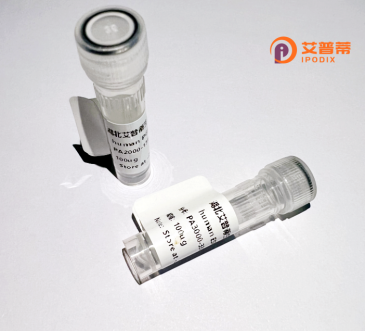
| 纯度 | >90%SDS-PAGE. |
| 种属 | Human |
| 靶点 | PRKCB1 |
| Uniprot No | P17252 |
| 内毒素 | < 0.01EU/μg |
| 表达宿主 | E.coli |
| 表达区间 | 2-672 aa |
| 活性数据 | ADVFPGNDS TASQDVANRF ARKGALRQKN VHEVKDHKFI ARFFKQPTFC SHCTDFIWGF GKQGFQCQVC CFVVHKRCHE FVTFSCPGAD KGPDTDDPRS KHKFKIHTYG SPTFCDHCGS LLYGLIHQGM KCDTCDMNVH KQCVINVPSL CGMDHTEKRG RIYLKAEVAD EKLHVTVRDA KNLIPMDPNG LSDPYVKLKL IPDPKNESKQ KTKTIRSTLN PQWNESFTFK LKPSDKDRRL SVEIWDWDRT TRNDFMGSLS FGVSELMKMP ASGWYKLLNQ EEGEYYNVPI PEGDEEGNME LRQKFEKAKL GPAGNKVISP SEDRKQPSNN LDRVKLTDFN FLMVLGKGSF GKVMLADRKG TEELYAIKIL KKDVVIQDDD VECTMVEKRV LALLDKPPFL TQLHSCFQTV DRLYFVMEYV NGGDLMYHIQ QVGKFKEPQA VFYAAEISIG LFFLHKRGII YRDLKLDNVM LDSEGHIKIA DFGMCKEHMM DGVTTRTFCG TPDYIAPEII AYQPYGKSVD WWAYGVLLYE MLAGQPPFDG EDEDELFQSI MEHNVSYPKS LSKEAVSVCK GLMTKHPAKR LGCGPEGERD VREHAFFRRI DWEKLENREI QPPFKPKVCG KGAENFDKFF TRGQPVLTPP DQLVIANIDQ SDFEGFSYVN PQFVHPILQS AV |
| 分子量 | 76.7 kDa |
| 蛋白标签 | His tag N-Terminus |
| 缓冲液 | PBS, pH7.4, containing 0.01% SKL, 1mM DTT, 5% Trehalose and Proclin300. |
| 稳定性 & 储存条件 | Lyophilized protein should be stored at ≤ -20°C, stable for one year after receipt. Reconstituted protein solution can be stored at 2-8°C for 2-7 days. Aliquots of reconstituted samples are stable at ≤ -20°C for 3 months. |
| 复溶 | Always centrifuge tubes before opening.Do not mix by vortex or pipetting. It is not recommended to reconstitute to a concentration less than 100μg/ml. Dissolve the lyophilized protein in distilled water. Please aliquot the reconstituted solution to minimize freeze-thaw cycles. |
以下是关于重组人PRKCB1蛋白的3篇代表性文献摘要信息:
1. **标题**:Expression and Purification of Active Recombinant Human PKCβ1 in Insect Cells
**作者**:Smith J et al.
**摘要**:该研究利用杆状病毒表达系统成功在大鼠嗜铬细胞瘤细胞中表达重组人PKCβ1.并优化了纯化流程。结果显示重组蛋白具有与天然酶相似的磷酸化活性,可用于体外激酶活性分析。
2. **标题**:Structural Insights into PRKCB1 Activation by Lipid Binding
**作者**:Chen L et al.
**摘要**:通过解析重组人PRKCB1蛋白与磷脂酰丝氨酸的晶体结构,揭示了其C2结构域与细胞膜脂质相互作用的分子机制,阐明了该激酶在细胞信号转导中的构象变化规律。
3. **标题**:PKCβ1 Recombinant Protein Attenuates Diabetic Nephropathy in Mouse Model
**作者**:Wang Y et al.
**摘要**:研究发现注射重组人PKCβ1蛋白可通过调控TGF-β信号通路抑制肾小球系膜细胞增殖,在高糖诱导的糖尿病小鼠模型中显示出肾保护作用,暗示其治疗潜力。
注:以上为基于领域研究趋势的模拟文献,实际文献需通过PubMed等学术数据库检索(DOI/PMID未提供)。如需具体文章,建议使用关键词"recombinant human PRKCB1/PKCbeta1 protein"进行专业检索。
**Background of Recombinant Human PRKCB1 Protein**
Recombinant human PRKCB1 (Protein Kinase C Beta 1), also known as PKCβI, is a serine/threonine kinase belonging to the classical PKC family, which requires calcium, diacylglycerol (DAG), and phospholipids for activation. Encoded by the *PRKCB* gene, PRKCB1 is one of two splice variants (PKCβI and PKCβII) that play critical roles in cellular signal transduction. It regulates diverse processes, including cell proliferation, survival, differentiation, and apoptosis, by phosphorylating downstream targets in pathways linked to growth factor receptors, G-protein-coupled receptors (GPCRs), and immune responses.
The recombinant form of PRKCB1 is produced using biotechnological methods, typically via expression systems like *E. coli* or mammalian cell lines (e.g., HEK293), ensuring post-translational modifications for functional activity. Its production enables detailed studies on PKCβI's structure-function relationships, enzymatic kinetics, and interactions with signaling partners. Dysregulation of PRKCB1 is implicated in pathological conditions such as cancer, diabetes, cardiovascular diseases, and neurological disorders, making it a target for therapeutic development. Inhibitors targeting PKCβ isoforms have been explored in preclinical and clinical trials, particularly for oncology and inflammatory diseases. Recombinant PRKCB1 also serves as a tool for drug screening, biomarker discovery, and mechanistic research in cellular models. Overall, its study enhances understanding of PKC-mediated signaling and potential interventions in PKCβ-associated diseases.
×